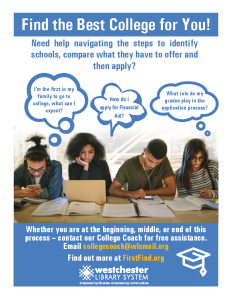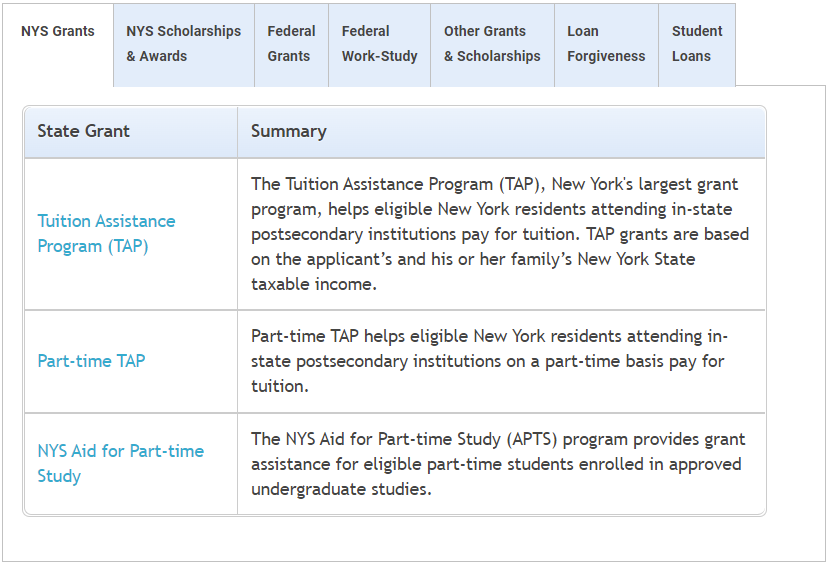College Options and Alternatives
Big Future (from College Board) covers more than 2000 colleges in the United States. You’ll also find information on majors and related careers.
College Score Card (from US Dept. of Education) Use objective data on which to compare schools; build your list by searching for schools or fields of study. Compare schools based on objective criteria such as Average Annual Cost, Graduation Rate, or % Earning More than a High School Graduate.
NYS Department of Labor | The Council of Industry are two good sources to understand apprenticeship options – jobs where you are paid as you learn a skill for today’s industries.
Evaluating a 4-year or 2-year program | 2 year degree at Westchester Community College. Read the first for a reasoned comparison (including why you might want to consider vocational or apprenticeship programs) and then jump to our local community college site for more information.
My Next Move A U.S. Department of Labor website offers guidance on careers, including employment projections and questions to help determine careers appropriate to your interests. Use the search boxes to explore!
Get Support
GEAR UP is a national initiative to create innovative programs that assist low-income students in preparing to enter and succeed in postsecondary education.
Higher Education Opportunity Program (HEOP) is a partnership between the State of New York and its independent colleges that provides scholarships to economically and educationally disadvantaged residents. It is mainly awarded to underrepresented minority students, such as African Americans and Hispanics. Call (518) 474-3719 to get started.
Latino U College Access (LUCA) serves high school juniors are nominated by their school guidance counselor if they are First-Gen Latino, and high achieving students from a low-income background. Program is active in these school districts: White Plains, Tarrytown, Ossining, and Elmsford. See also their Spanish-language seminars on Spanish language presentations on applying and paying for college.
SUNY Educational Opportunity Program (EOP) may be able to help if you think your grades won’t get you an acceptance..just yet!
uASPIRE offers direct assistance and workshops (all online) as well as video guidance on FAFSA process (see financial aid section below).
Upward Bound serves high school students from low-income families and those who would be the first in their family to attend college. Support addresses high school completion and pre college planning.
WLS College Coach offers free assistance whether you are at the beginning, middle, or end of this process.
Yonkers Partner in Education (YPIE) provides college support within the Yonkers School District.
Understand and Apply for Financial Aid
FAFSA (U.S. Dept. of Education’s Free Application for Federal Student Aid) is the form you need to fill out to get any financial aid from the federal government to help pay for college. Each year, over 13 million students who file the FAFSA get more than $120 billion in grants, work-study, and low-interest loans from the U.S. Department of Education.offered as a step-by-step prcess with worksheets, charts, and lots of instructions.
UnderstandingFAFSA.org provides an annually updated booklet (in 10 languages!) with more information about FAFSA. Their website also provides specialized advice for students with special circumstances like homelessness or being undocumented.
Higher Education Services Corporation (HESC) College Financial Advisor asks a few simple qestions to create a personalized HESC Pay for College Action Plan and Information Summary based on your borrowing needs and unique circumstances.
HESC Financial Aid Award Letter Comparison Tool helps you evaluate your financial aid packages and determine the bottom line cost – the difference between the cost of attendance and your financial aid package – for each college. It may surprise you that the school with the highest cost of attendance may not be the most expensive for you to attend! You see how much is: “Free money” – grants and scholarships that don’t have to be paid back; Loans – that do need to be paid back – with interest; and what you still need to pay.
The College Board’s CSS Profile is an online application that collects information used by hundreds of colleges, universities, professional schools, and scholarship programs to award financial aid from sources outside of the federal government. The CSS Profile is an application that universities use to gauge how much non-federal financial aid you need; this is different from FAFSA, which focuses on federal grants, loans, and other types of government assistance.
The New York State Tuition Assistance Program (TAP) helps eligible New York residents pay tuition at approved schools in New York State.


